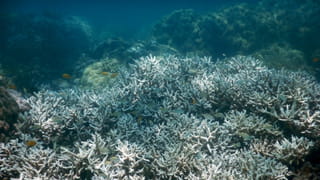The Great Barrier Reef is dying at an unprecedented pace. If it weren’t for the coronavirus pandemic, this would be front page news. It’s a problem with consequences far beyond the Australian coast.
Coral reefs are the most important oceanic ecosystem, and the Great Barrier Reef is the largest living structure on Earth. Worldwide, reefs comprise just 0.2% of the ocean’s area, but support about one-quarter of all marine species. More than 500 million people worldwide depend on coral reefs, and the life they harbour, for their livelihoods and food.
And here’s the bad news: over the past few weeks, Australia’s Great Barrier Reef has undergone an intense bout of coral bleaching, its third severe shock in the past five years. More than 60% of the 1,036 reefs surveyed within the Great Barrier Reef have experienced at least moderate bleaching this year.
"Witnessing the extent of the coral bleaching, and knowing this is inextricably linked to increasing greenhouse gas emissions, leaves me angry and bewildered," Morgan Pratchett, a coral reef ecologist, told me. "We can safely assume that not only have a lot of corals bleached, but many will also die." Pratchett personally conducted the underwater surveys in recent weeks that helped scientists determine the severity of the bleaching.
The previous two episodes of coral bleaching, in 2016 and 2017, were likely the first time in thousands of years that the Great Barrier Reef has suffered consecutive years of widespread damage due to a severe oceanic heatwave. About half the shallow-water corals in the Great Barrier Reef died between 2016 and 2017. So far in 2020, the bleaching is even more extensive.
While conducting a companion aerial survey, Australia-based coral scientist Terry Hughes posted a video on Twitter with a sombre message: “I feel like an art lover wandering through the Louvre...as it burns to the ground.” In a follow-up message this week, Hughes said: “I’m not sure I have the fortitude to do this again. It’s heartbreaking to see the #GreatBarrierReef decline so fast.”
What is coral bleaching?
Coral themselves are tiny animals that secrete calcium carbonate for protection, the same relatively hard material that forms the basis of eggs and shells in many other animals. Coral live in colonies, and over thousands of years can build impressive reefs. The Great Barrier Reef is the world’s largest, but there are important reef ecosystems along virtually every coastline in every ocean basin, including near Antarctica.
Bleaching occurs when coral become stressed, either by warm water, pollution or changes in salinity – and reflexively expel their symbiotic algae that are their primary food source. The reefs can turn a ghostly white colour in a matter of days, and if the algae do not recolonise the reefs within a few weeks, the corals can die. When corals die en masse, as they did globally in 2016 and 2017, it can trigger a widespread collapse of the oceanic food chain.
The most widespread bleaching of the Great Barrier Reef ever
In recent years, as global heating records continue to be broken, the warnings from the Intergovernmental Panel on Climate Change (IPCC) have grown more dire.
In their latest report devoted to ocean health, the world’s foremost authority on climate science said that if warming exceeds 1.5C above pre-industrial levels, around 90% of the world’s corals could die. Current temperatures are about 1.2C above that long-term average. Unless drastic changes happen over the next decade, most of the world’s reefs are headed toward extinction.
"The Great Barrier Reef will continue to lose corals from heat stress, until global emissions of greenhouse gasses are reduced to net zero, and sea temperatures stabilise," wrote Pratchett and Hughes in a joint statement. "Without urgent action to achieve this outcome, it’s clear our coral reefs will not survive business-as-usual emissions."
What’s worse, the current coral bleaching is happening without the extra boost from El Niño, which has been a key driver in every other major global bleaching event on record.
"We can confidently say this is the first Great Barrier Reef bleaching tied strictly to human-caused climate change," Mark Eakin, a US government scientist who monitors coral health worldwide, told me. “It’s a real gut-punch. With no El Niño, we really weren’t expecting another major bleaching. But here we are in 2020 with the most widespread bleaching of the Great Barrier Reef ever.”
Water temperatures this year have reached new records in Australia and around the Earth as a whole. Southern Africa, Indonesia, the South Pacific, and parts of Brazil have also seen temperatures hot enough during the just-completed southern hemisphere summer to trigger potential coral bleaching. In the coming months, that abnormal heat will spread northward and is forecasted to impact east Africa, the Philippines, the islands of the central Pacific, and more extensive parts of Brazil.
In places more reliant on subsistence fishing than Australia, bleaching can be a death sentence for human communities, too, and overfishing is already stressing local ecosystems. New research published this year shows that coral bleaching in polluted waters is also much more severe, even with the same level of heating.
A narrow window of opportunity to save the coral reefs
Overlapping crises are a hallmark of an era of climate emergency. There is perhaps no place in the world where this is currently felt more acutely than in Australia. The latest coral bleaching comes on the heels of the worst bushfire season in living memory, and amid the global economic and social crisis of the Covid-19 pandemic.
Tourist areas in the Great Barrier Reef were already struggling to recover after the last mass bleaching episode, and this will only compound the existential threat that continued use of fossil fuels poses to the reef and the communities it supports. In its statement confirming the current bleaching, the Great Barrier Reef Marine Park Authority said “climate change remains the single greatest challenge to the reef”.
Unless we act fast to make sure we don’t pass the 1.5C threshold, we face a future without the Great Barrier Reef.
What coral scientists in particular and ocean scientists in general point out is the remarkable ability for marine ecosystems to heal if given a chance. With the right mix of aggressive policies, research shows that ocean life can still rebound over the coming decades. All is not yet lost.
The past couple of months, we’ve seen changes we didn’t think were possible. We know the Great Barrier Reef won’t survive on our current path. The good news is that, like recovery from a global pandemic, the oceans can also heal.
The coronavirus shows that our policies "can transform overnight if we as a society collectively deem it necessary," marine socioecologist Gretta Pecl told me. "We don’t ‘need’ 10 or 20 years for science to inform policy; if we want it badly enough everything can swing on a dime.”
Dig deeper
 Climate change is only half the problem. We’re destroying the Earth’s layer of life
Along with the climate crisis, the disappearance of non-human life is our most pressing problem. To fully understand how big the problem is, we need to think of this loss in terms of biomass instead of the number of species.
Climate change is only half the problem. We’re destroying the Earth’s layer of life
Along with the climate crisis, the disappearance of non-human life is our most pressing problem. To fully understand how big the problem is, we need to think of this loss in terms of biomass instead of the number of species.


